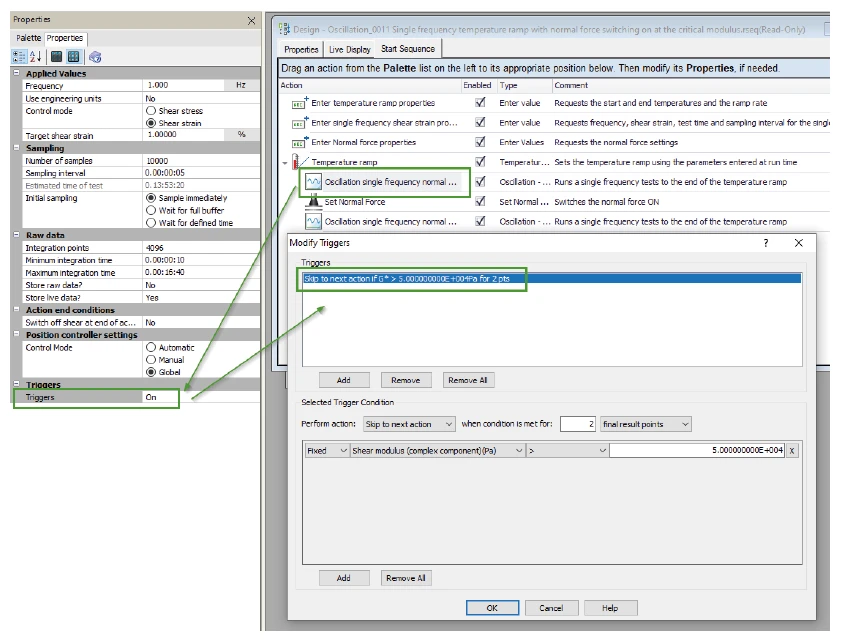Introduction
The Kinexus rotational rheometer system by NETZSCH has a range of disposable plate systems (Table 1) all based on the same common design (see Figure 1), for the various different temperature control systems available. These are perfect for when the sample is expected to cure/adhere strongly to the measuring system, making standard cleaning all but impossible. For these challenging samples, the unique Kinexus design enables routine measurements with minimal material waste/ environmental impact and low cost with a rapid test turnaround time.
This system comprises of a new quick connect (non-disposable) upper geometry shaft (Figure 1, (1)) with autorecognition/ configuration and a lower plate (2), which are both used to securely hold the low-priced and disposable sample facing plates (4). The upper plates (3) are available in a variety of sizes (typically from 10 mm to 40 mm, see Table 1) in various quantities depending on testing needs.
Kinexus Active Hood
The Kinexus active hood contains unique technology to prevent the formation of thermal gradients across the sample. For measurements where the absolute temperature is key, the Kinexus active hood system should be considered.
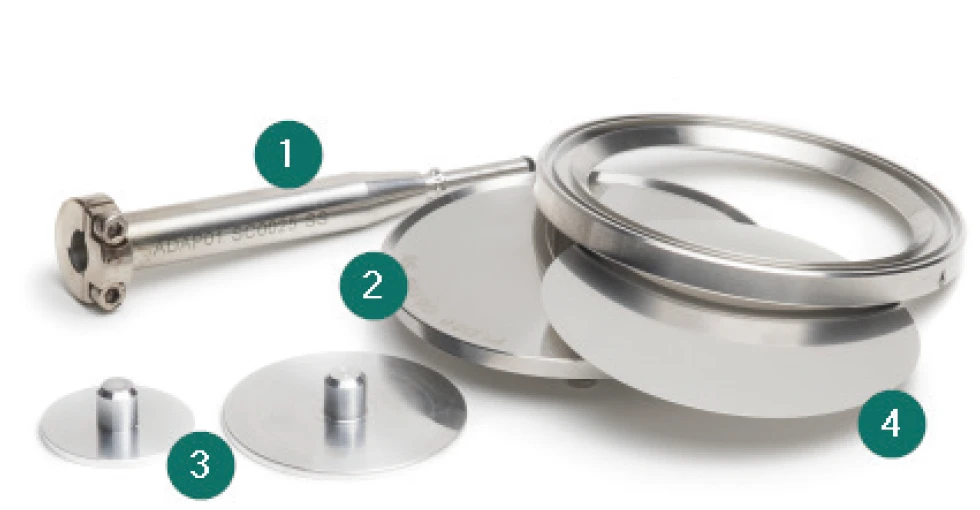
Table 1 and Table 2 show the different cartridge systems and disposable plates available for the Kinexus rotational rheometers.
Table 1: Disposable plate system compatibility
* depending on the optional cooling system
| Kinexus Cartridge System | Temperature Range | |
| Plate (Peltier) | -40 (-5)* to 200°C | |
| Plate (Peltier), E-variant | -40 (-5)* to 150°C | |
| Active hood (Peltier) | -40 (-5)* to 200°C | |
| Active hood (Peltier), E-variant | -40 (-5)* to 150°C | |
| HTC plate | 0 (ambient)* to 350°C | |
Table 2: Common disposable plate consumables
* For details, please see the Kinexus accessory brochures
| Disposable Plate Consumables | Material | |
| Disposable plate sets (upper and lower) |
| |
| 40-mm set | Aluminum upper, stainless steel lower | |
| 40-mm set | Stainless steel upper and lower | |
| 25-mm set | Aluminum upper, stainless steel lower | |
| 25-mm set | Stainless steel upper and lower | |
| Disposable lower plate only | ||
| Disposable lower plate | Stainless steel | |
| Disposable upper plates only | ||
| 40 mm | Aluminum | |
| 25 mm | Aluminum | |
| 12 mm | Aluminum | |
| 10 mm | Aluminum | |
rSpace for Kinexus: Rheology Software to Guide through the Measurements
rSpace takes a unique guided approach to rheology measurements with test methods are called sequences.
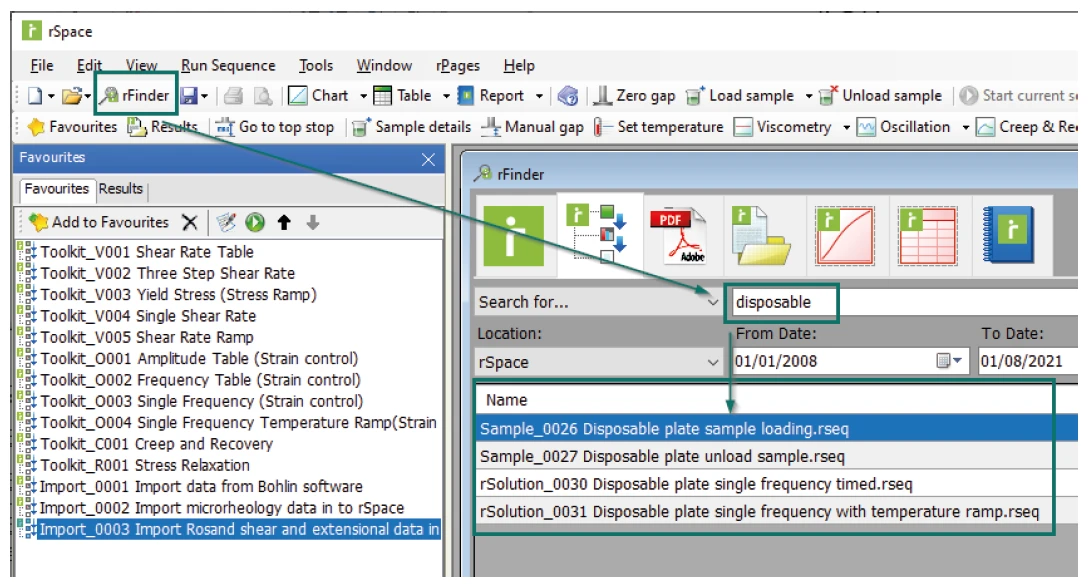
Hundreds of pre-configured sequences are supplied with rSpace for users to use and edit for their own specific needs. This includes sequences for Curing (Crosslinking Reactions)Literally translated, the term “crosslinking“ means “cross networking”. In the chemical context, it is used for reactions in which molecules are linked together by introducing covalent bonds and forming three-dimensional networks.curing samples that are chemically* initiated (e.g., two-part epxoy systems) or thermally** initiated (e.g., thermosets). A custom “Event timer” is included so that samples that are initiated by an external means (for example mixing a two part-epoxy) are all timed (for accurate comparisons of different samples) to the critical time when the sample is mixed (see Figure 3).
All disposable plate sequences guide the user step-bystep on how to assembly, mount, use and remove the disposable plate systems (Figure 4). Of course, this is all with the standard rSpace flexibility of being able to be customized for every specific testing requirement.
Design sequences, labelled “Sample_” are also included to both separately load (Sample_0026) and unload (Sample_0027) the disposable plates and Curing (Crosslinking Reactions)Literally translated, the term “crosslinking“ means “cross networking”. In the chemical context, it is used for reactions in which molecules are linked together by introducing covalent bonds and forming three-dimensional networks.curing sample, or for use to be imported into your own custom measurement sequence.
* in Kinexus rSpace software rSolution_0030
** in Kinexus rSpace software rSolution_0301
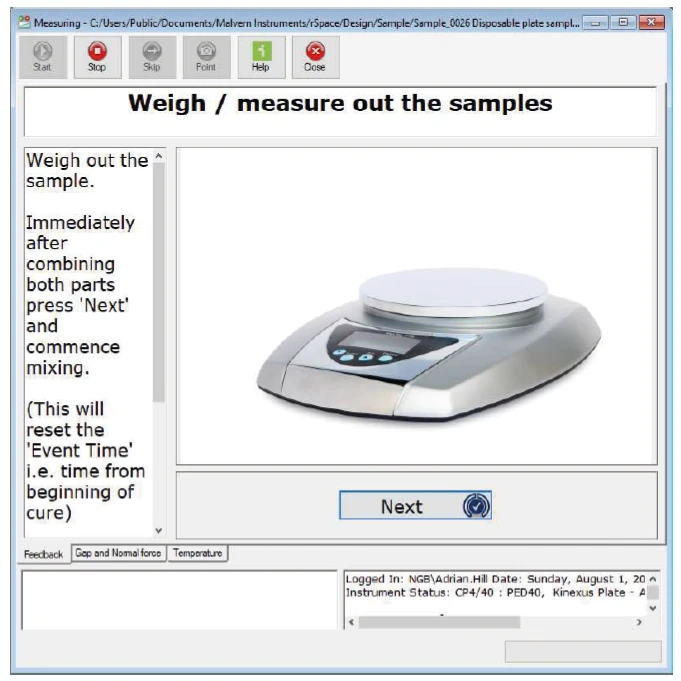
Usage Tip
Depending on the particular sample properties, it is sometimes possible to remove (peel off) the flexible lower plate system along with the sample to enable to reuse of the disposable upper plate.
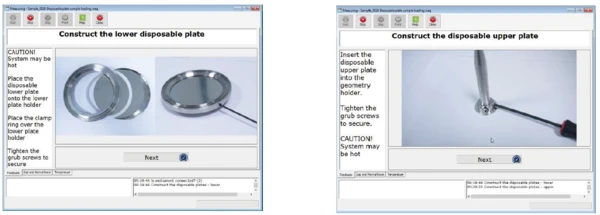
Usage Tip
For samples that have a large tendency to shrink, it is advisable to place a drop of liquid (water for lower temperatures, oil for higher temperatures) between the lower plate adapter and the disposable lower plate. This further increases the rigidity of the system.
Phase Angle
The phase angle is a relative measure of the viscous and elastic properties of a material. It range from 0° for a fully elastic meaterial to 90° for a fully viscous material. It can be considered the “degree of fluidity”.
Curing Profiles Measured by Rheometry
Typical Curing (Crosslinking Reactions)Literally translated, the term “crosslinking“ means “cross networking”. In the chemical context, it is used for reactions in which molecules are linked together by introducing covalent bonds and forming three-dimensional networks.curing profiles of two different samples measured with the disposable plate system are shown in Figure 5 using a single frequency oscillation. Typical properties are that the phase angle (green curve) starts high (i.e., viscous/liquid like), and then lowers (i.e., more elastic/ like) as the cure proceeds. Simultaneously, the materials (complex) modulus (as indicated by the combination of elastic and Viscous modulusThe complex modulus (viscous component), loss modulus, or G’’, is the “imaginary” part of the samples the overall complex modulus. This viscous component indicates the liquid like, or out of phase, response of the sample being measurement. viscous modulus) increases as the sample gets “stiffer”.
This can also be monitored with the elastic (G’, red symbols) and viscous (G’’, blue symbols) modulus where they both tend to increase as the cure progresses, with initially the Viscous modulusThe complex modulus (viscous component), loss modulus, or G’’, is the “imaginary” part of the samples the overall complex modulus. This viscous component indicates the liquid like, or out of phase, response of the sample being measurement. viscous modulus dominating (as more liquid like, phase angle >45°) then a “cross-over point” where the Viscous modulusThe complex modulus (viscous component), loss modulus, or G’’, is the “imaginary” part of the samples the overall complex modulus. This viscous component indicates the liquid like, or out of phase, response of the sample being measurement. viscous modulus = Elastic modulusThe complex modulus (elastic component), storage modulus, or G’, is the “real” part of the samples the overall complex modulus. This elastic component indicates the solid like, or in phase, response of the sample being measurement. elastic modulus (due to the phase angle = 45°) which can also be referred to as a “gel point”1, until finally the Elastic modulusThe complex modulus (elastic component), storage modulus, or G’, is the “real” part of the samples the overall complex modulus. This elastic component indicates the solid like, or in phase, response of the sample being measurement. elastic modulus dominates over the Viscous modulusThe complex modulus (viscous component), loss modulus, or G’’, is the “imaginary” part of the samples the overall complex modulus. This viscous component indicates the liquid like, or out of phase, response of the sample being measurement. viscous modulus. Depending on the material, a plateau in the curve of the phase angle and/or the moduli may indicate the final cure. At this point, alternative characterization (such as DMA, with the NETZSCH DMA 242 Artemis) would be more suitable; the disposable plate system is designed to monitor the progression of the cure.

1 There are multiple definitions of the gel point. A simple convenient one (as detailed in ASTM 4473) is where G’ = G’’ (i.e., phase angle = 45°) but this would change depending on the applied frequency of the oscillation. A more detailed definition of the sol-gel transition is detailed by Winter & Chambon (Chambon, 1987) as the point where the phase angle is independent of frequency (rather than 45°).
During Curing (Crosslinking Reactions)Literally translated, the term “crosslinking“ means “cross networking”. In the chemical context, it is used for reactions in which molecules are linked together by introducing covalent bonds and forming three-dimensional networks.curing processes, some materials can change in volume, either expansion of contraction, which can also be monitored on Kinexus during the same curing test. Often, these changes are unwanted. However, sometimes (depending on end use) this can provide helpful information on the process, such as sample expanding in a cavity that the adhesive is required to fill, or avoid contraction which can put immediate and unwanted stresses onto a bond. For any of these scenarios, Kinexus is available to quantity this change. Either by fixing the gap and monitor the changes in “Normal Force” (axial force; positive value being up, negative down) to indicate the “tendency” of a material to want to change volume, or maintaining.
Advanced Test Control: rSpace Triggers
The Kinexus rSpace software has advanced control over normal force measurements by use of the “Trigger” system. This means, even during a measurement, the control of the sequence can change with the trigger condition met, hence “triggering” a different action, for example. Figure 6 shows a typical example of how the trigger system works for a curing material which is initially “viscously dominated” (i.e., a viscoelastic liquid, so a tendency to flow). As such, an initial applied normal force would push (flow) the sample out of the measurement gap. In this viscous state, the sample will flow as it cannot apply an outwardly force as the sample will just otherwise deform (to relax) instead (hence no net change in normal force). As such, the sequence starts in a fixed gap measurement, “triggering” to normal force control (i.e., variable gap) once the sample is too high in modulus so no longer likely to be viscously dominated enabling the sample to likely to expand or contract.
Further bespoke and flexible control, is available with this unique and flexible trigger system supplied with rSpace; most instrument variables are available to be trigger on.
The Kinexus disposable plate system retains compatibility for use with the Kinexus solvent trap systems:
- Kinexus passive solvent trap cover for standard plate and cylinder cartridges only, made of stainles steel
- Kinexus active solvent trap cover for active hood cartridge only, made of stainless steel
